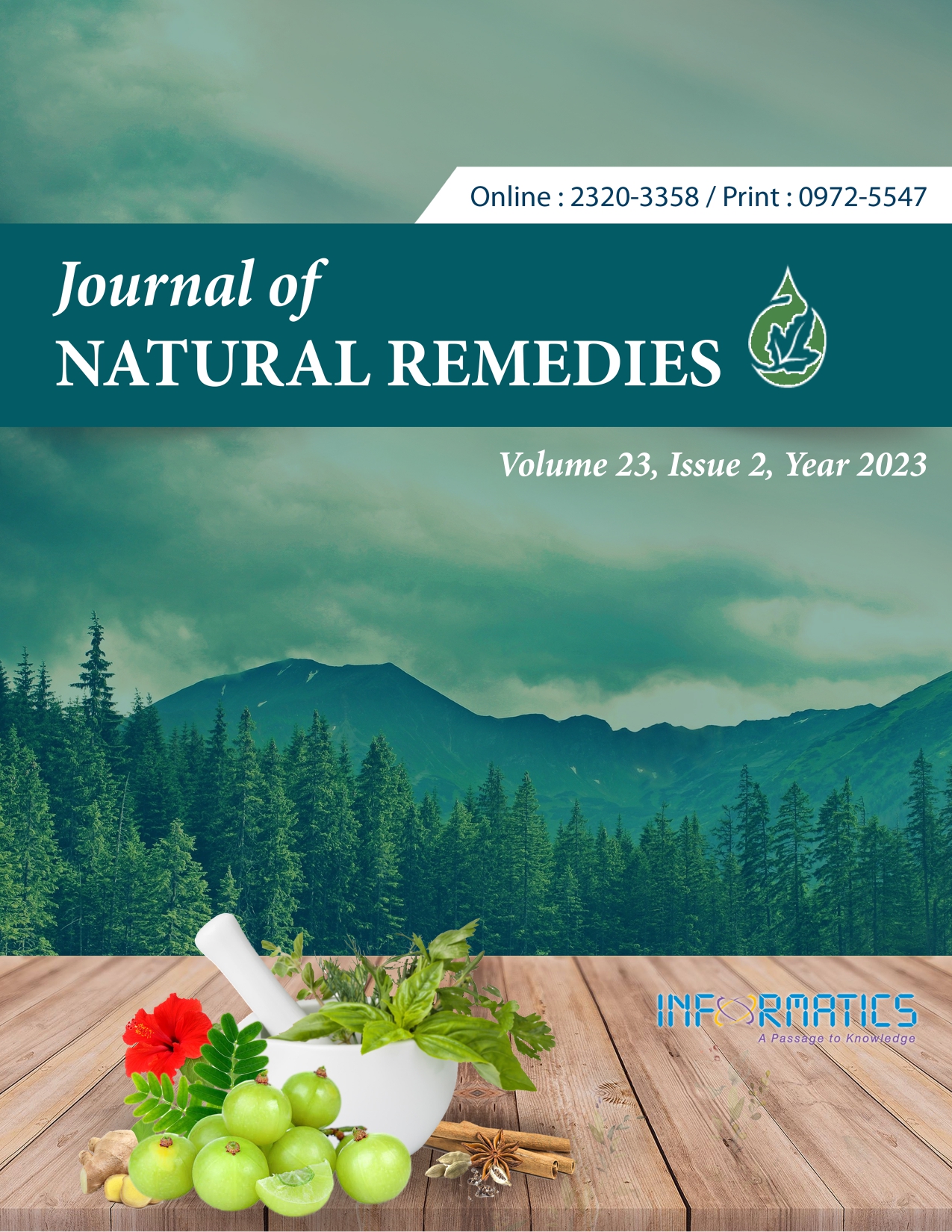5α-Reductase Inhibitory Potential of Hibiscus rosa sinensis: Effective for the Management of Alopecia
DOI:
https://doi.org/10.18311/jnr/2023/31180Keywords:
Alopecia, Hair Loss, Hibiscus rosa sinensis, NADPH, Quercetin, 5α-ReductaseAbstract
The condition known as male pattern hair loss and benign prostatic hyperplasia are both treated with a family of drugs known as 5 alpha reductase (5α-reductase) inhibitors. This study shows that the flower of Hibiscus rosa sinensis has 5α-reductase inhibitory action that is helpful in the treatment of androgenic diseases. Phytochemical screening was done using petroleum ether, methanol, and water extracts to identify the phytochemical group present. Then, using quercetin as a reference flavonoid component, the Total Flavonoid Content (TFC) was assessed using a colorimetric technique. The 5α-reductase inhibitory activity was evaluated using several extracts and compared to the well-known 5α-reductase inhibitor finasteride. Finally, the inhibition of different extracts to the enzyme was assessed using a biochemical approach to measure the activity of 5α-reductase. It was determined that the IC<sub>50</sub> value of Hibiscus rosa sinensis methanolic extract, 146.048 ± 0.453 (μg/mL) and quercetin (a chemical biomarker of the plant material) 141.426 ± 1.578 (μg/mL), were promising candidates for future investigation into their antiandrogenic activities.
Downloads
Metrics
Downloads
Published
How to Cite
Issue
Section
License
Copyright (c) 2023 ARPAN CHAKRABORTY, Arka Bhattacharjee, Baishakhi Mondal, Manas Chakraborty, Goutam Mukhopadhyay

This work is licensed under a Creative Commons Attribution 4.0 International License.
Accepted 2023-04-24
Published 2023-06-13
References
Lieberman R. Evolving strategies for prostate cancer chemoprevention trials. World J Urol. 2003; 21(1):3- 8. https://doi.org/10.1007/s00345-003-0317-4 DOI: https://doi.org/10.1007/s00345-003-0317-4
Wright AS, Douglas RC, Thomas L.N, Lazier CB, Rittmaster RS. Androgen-induced regrowth in the castrated rat ventral prostate: role of 5α-reductase. Endocrinol. 1999; 140(10):4509-4515. https://doi. org/10.1210/endo.140.10.7039 DOI: https://doi.org/10.1210/endo.140.10.7039
Levy MA, Brandt M, Sheedy KM, Holt DA, Heaslip JI, Trill, JJ, Ryan PJ, Morris R, Garrison LM, Bergsma DJ. Cloning, expression and functional characterization of type 1 and type 2 steroid 5α-reductase from Cynomolgus monkey: Comparisons with human and rat isoenzymes. Steroid Biochem. Mol. Biol. 1995; 52:307-319. https:// doi.org/10.1016/0960-0760(94)00183-M DOI: https://doi.org/10.1016/0960-0760(94)00183-M
Guarna A, Poletti A, Catrambone F, Danza G, Marrucci A, Serio M, Celotti F, Martini L. Synthesis of a chemiluminescent probe useful for the purification of steroid 5α-reductase. Bio org Med Chem Lett. 1996; 6(16):1997-2002. https://doi.org/10.1016/0960-894X(96)00360-5 DOI: https://doi.org/10.1016/0960-894X(96)00360-5
Russell DW, Wilson JD. Steroid 5α-reductase: two genes/two enzymes. Annu. Rev Biochem. 1994; 63(1): 25-61. https://doi.org/10.1146/annurev.bi.63.070194.000325 DOI: https://doi.org/10.1146/annurev.bi.63.070194.000325
Jadhav VM, Thorat RM, Kadam VJ, Sathe NS. Hibiscus rosa sinensis Linn-’’Rudrapuspa’’: A review. J Pharm Res. 2009; 2(7):1168-73.
Ross IA. Hibiscus rosa-sinensis. In medicinal plants of the world. Humana Press, Totowa, NJ. 2003; 253-266. https://doi.org/10.1007/978-1-59259-365-1_12 DOI: https://doi.org/10.1007/978-1-59259-365-1_12
Rathi V, Rathi J, Tamizharasi S, Pathak A. Plants used for hair growth promotion: A review. Phcog Rev. 2008; 2(3):185.
Singh R, Kori ML. Phytochemical studies of Tephrosia purpurea Linn. and Martynia annua Linn. extracts for identification of chemical constituents. Int J Pharm Sci Drug Res. 2022; 14(2):226-232. https://doi.org/10.25004/IJPSDR.2022.140211 DOI: https://doi.org/10.25004/IJPSDR.2022.140211
Sheth F, De S. Evaluation of comparative antioxidant potential of four cultivars of Hibiscus rosa-sinensis L. by HPLC-DPPH method. Free radic antioxid. 2012; 2(4):73-78. https://doi.org/10.5530/ax.2012.4.13 DOI: https://doi.org/10.5530/ax.2012.4.13
Nahata A, Dixit VK. Evaluation of 5α‐reductase inhibitory activity of certain herbs useful as antiandrogens. Andrologia. 2014; 46(6):592-601. https:// doi.org/10.1111/and.12115 DOI: https://doi.org/10.1111/and.12115
Wikramanayake TC, Villasante AC, Mauro LM, Perez CI, Schachner LA, Jimenez JJ. Prevention and treatment of alopecia areata with quercetin in the C3H/HeJ mouse model. Cell Stress Chaperones. 2012; 17:267-274. https://doi.org/10.1007/s12192-011-0305-3 DOI: https://doi.org/10.1007/s12192-011-0305-3
Zhao Q, Zheng Y, Zhao D, Zhao L, Geng L, Ma S, Cai Y, Liu C, Yan Y, Belmonte JC, Wang S. Single-cell profiling reveals a potent role of quercetin in promoting hair regeneration. Protein and Cell. 2022; 1-18. https://doi.org/10.1093/procel/pwac062 DOI: https://doi.org/10.1093/procel/pwac062

 Arpan Chakraborty
Arpan Chakraborty









 0.35
0.35 24
24 0.161
0.161